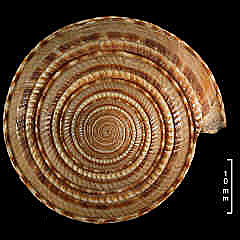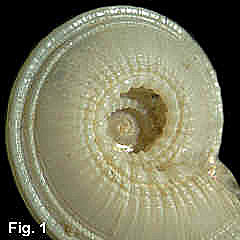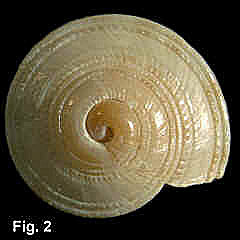|
< Previous family introduction |
|
|||||
 |
Family Architectonicidae Sundial Shells
|
|||||
|
The Architectonicidae, or sundial shells, is a distinctive group of molluscs with a low conical shell with a widely open umbilicus. They vary from large colourful shells found in the shallow sublittoral to minute, colourless species occurring in the bathyal zone. There are about 140 living species worldwide, most commonly occurring in the shallow subtidal zone in the tropics and subtropics, and concentrated in the Indo-West Pacific Ocean, but there are representatives in temperate waters, from the intertidal down to the bathyal zone. Architectonicids generally live subtidally, although the only common species in NSW is an exception and occurs intertidally and in the shallow subtidal Their habitats are of two major types (Bieler, 1993, p. 25). The first habitat type is in sandy situations, where there is a depressed shell with a sharp peripheral keel that allows easy burrowing in sand. The second habitat type is on hard substrates such as rocks and corals, where there is a more rounded shell. The large species of Architectonica have an intermediate shell shape, as they rest in the sand and emerge to search for food on a variety of substrates. The diet of the Architectonicidae is sea anemones, zooanthids and corals; they rasp a hole in the polyp with their radula and suck out the fluids and tissue. There are several reproductive modes in the Architectonicidae. Some species have fixed separate male and female individuals throughout life, while others are simultaneous or consecutive hermaphrodites. In Architectonica and Heliacus eggs are deposited in soft, gelatinous sausage-shaped masses attached to the substrate, with tens of thousands of eggs in each deposit. Veliger larvae hatch from the egg masses and are released into the water, where they are free-swimming and feed, probably on single-celled algae. There is a long pelagic stage, up to six months or more, which accounts for the wide distribution of some architectonicid species. The species that occur in NSW fall into three distributional groups. The largest group is the widespread tropical Indo-West Pacific species that occur around northern Australia and reach into northern NSW. Of these, some reach as far south as Sydney, one reaches the Victorian border, while the others cut out on the northern NSW coast. A second group is widely distributed deep-water species, such as Pseudotorinia delectabilis (Melvill, 1893) which occurs throughout the Indian and Western Pacific Oceans and around all of the Australian coastline except for the south-east. The third group consists of only a few species that occur intertidally and in the shallow subtidal in southern Australia, notably Philippia lutea (Lamarck, 1822). The taxonomy of the family in NSW is better known than that of most mollusc families. In the 1930s Tom Iredale described ten species, and in the 1962 checklist (Iredale & McMichael, 1962) there were 14 species recognised from the state. Tom Garrard in 1977 reviewed all the Australian species, and Rüdiger Bieler documented all the Indo-West Pacific fauna in 1993. These treatments reduced most of Iredale's species to synonymy. In this work, which is based on Bieler's treatment, 21 species are recognised.
Family References Bieler, R. 1993. Architectonididae of the Indo-Pacific (Mollusca, Gastropoda). G. Fischer: Stuttgart. Garrard, T.A. 1977. A revision of the Australian Architectonicidae (Gastropoda: Mollusca). Records of the Australian Museum 31 (13) 506–584
Coverage In addition to the species detailed here, the following two species are recorded from NSW: Architectonica perdix (Hinds, 1844) is known by only one NSW specimen, from Yamba. The next northernmost record is Caloundra, Qld. Heliacus stramineus (Gmelin, 1791). Indo-West Pacific. Two NSW specimens, from off Clarence River in 50–70 m.
Identification Notes The low, conical shape and widely open umbilicus allow easy assignment of shells to this family. An additional feature is the heterostrophic protoconch, in which the earliest whorls are coiled in the opposite direction to the latter whorls. This results in a reversal of the direction of shell growth; if the teleoconch is considered to be growing "downwards", the protoconch was growing "upwards". The earliest protoconch whorls can be seen through the umbilicus, as shown in Fig. 1, and latter protoconch whorls are visible externally, as shown in Fig. 2. The size groupings used for this family are:
|

